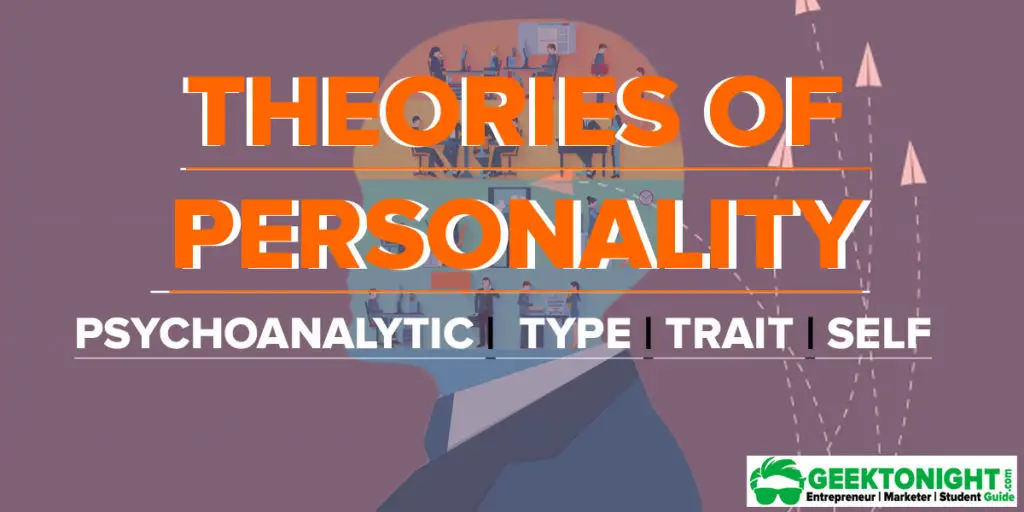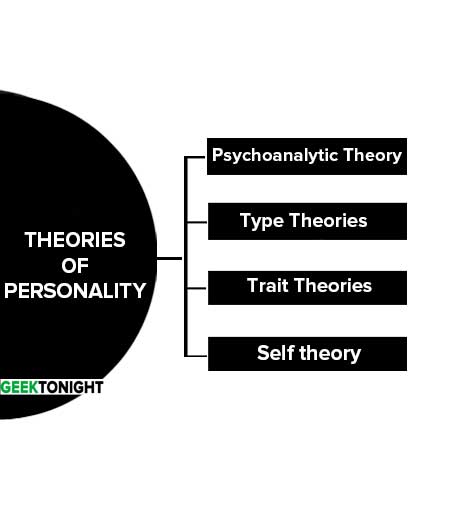What is Personality?
Personality is a pattern of stable states and characteristics of a person that influences his or her behaviour toward goal achievement. Each person has unique ways of protecting these states.

Table of Content
Theories of Personality
Since personality variables reflect consistent and enduring patterns of behaviour, these patterns can be classified into certain categories. so that the behaviour can be predictable once we identify the pattern of behaviour as belonging to a given category.
The theories of personality have been grouped as:

Psychoanalytic Theory
The Psychoanalytic theory of personality has held the interest of psychologists and psychiatrists for a long time. Sigmund Freud, its formulator, was quite an influence. It attends to emphasizes three main issues i.e. the id, the ego and the superego.
Components of Psychoanalytic Theory
Id
The id is the only part of the personality that is present at birth. It is inherited, primitive, inaccessible and completely unconscious.
The id operates according to the pleasure principle, that is, to seek pleasure, avoid pain and gain immediate gratification of its wishes.
The id contains:
(a) The life instincts, which are sexual instincts and biological urges such as hunger and thirst
(b) The death instinct, which accounts for our aggressive and destructive impulses.
Ego
The ego is the logical, rational, realistic part of the personality. The ego evolves from the id and draws its energy from the id.
One of the functions of the ego is to satisfy the id’s urges. But the ego, which is mostly conscious, acts according to the reality principle. It must consider the constraints of the real world in determining appropriate times, places, and object for gratification of the id’s wishes.
Superego
When the child is age 5 or 6 the superego – the moral component of the personality – is formed.
The superego has two parts:
(a) The “conscience“, consisting of all the behaviours for which we have been punished and about which we feel guilty
(b) The “ego ideal“, containing the behaviours for which we have been praised and rewarded and about which we feel pride and satisfaction.
In its quest for moral perfection, the superego, a moral guide, sets up signposts that define and limit the flexibility of ego.
Type Theories
The type theories represent an attempt to put some degree of order into the chaos of personality theory.
The type theory represents an attempt to scientifically describe personality by classifying individuals into convenient categories.
Two categories of type theories of personality are explained below:
Sheldon Physiognomy Theory
William Sheldon has presented a unique body-type temperamental model that represents a link between certain anatomical features and psychological traits with distinguishing characteristics of an individual and his behaviour.
Sheldon identifies three body types:
- Endomorph: He is bulky and beloved. Sheldon’s endomorph to be rather fat, thick in proportion to his height.
His personality temperament is viscerotonic (the person seeks comfort, loves fine food, eats too much, is jovial, affectionate and liked by all). - Mesomorph: He is basically strong, athletic and tough. All appreciate his physique. In fact, it is this personality all other “morphs” wish for.
According to Sheldon, he will tend to be somatotonic (he is fond of muscular activity; he tends to be highly aggressive, and self-assertive). - Ectomorph: These people are thin, long and poorly developed physically.
Though physically weak, he leads the league in the intelligent department.
Carl Jung Extrovert Introvert Theory
The way to type personality is in terms of behaviour or psychological factors. Jung’s introvert and extrovert types are an example.
However, as Carl Jung himself pointed out, the introvert-extrovert typology turns out to be more in the nature of a continuum than discrete, separate types. Carl Jung proposed his own two-part theory of personality.
Carl Jung two types are:
- Extrovert: They are optimistic, outgoing, gregarious and sociable. Extroverts are basically objective, reality-oriented individuals who are more doers than thinkers.
- Introverts: By contrast, introverts are more inward-directed people. They are less sociable, withdrawn and absorbed in inner life. They tend to be guided by their own ideas and philosophy.
Few people are complete introverts or extroverts, but the mixture of these two ingredients determines the kind of overall personality of an individual.
Trait Theories
Some early personality researchers believed that to understand individuals, we must break down behaviour patterns into a series of observable traits.
According to trait theory, a personality trait can be defined as an “enduring attribute of a person that appears consistently in a variety of situations”. In combination, such traits distinguish one personality from another.
A trait is a personal characteristic that is used to describe and explain personality. It is a list of relatively stable and consistent personal characteristics.
Gordon Allport Personality Traits
Gordon Allport claims that personality traits are real entities, physically located somewhere in the brain. We each inherit our own unique set of raw material for given traits, which are then shaped by our experiences.
Traits describe the particular way we respond to the environment and the consistency of that response. If we are shy, we respond to strangers differently than if we are friendly; if we are self-confident,
Gordon identified two main categories of traits:
1. Common Traits: Common traits are those we share or hold in common with most others in our own culture.
2. Individual Traits: According to Allport, there are three individual traits: cardinal, central and secondary traits.
- Cardinal Traits: A cardinal trait is “so pervasive and outstanding in a life that almost every act seems traceable to its influence”.
- Central Traits: According to Allport, are those that we would “mention in writing a careful letter of recommendation”.
- Secondary Traits: The secondary traits are less obvious, less consistent and not as critical in defining our personality as the cardinal and central traits. Examples of secondary traits are food and music preferences.
Raymond Cattell 16 Personality Factors
Raymond Cattell considered personality to be a pattern of traits providing the key to understanding and predicting a person’s behaviour.
Cattell identified two types:
- Surface Traits: Observable qualities of a person like honest, helpful, kind, generous etc., Cattell called these “surface traits”.
- Source Traits: Make up the most basic personality structure and, according to Cattell, actually cause behaviour. Intelligence is a source trait, and every person has a certain amount of it but, obviously not exactly the same amount or the same kind.
Self theory
The psychoanalytic, type and trait theories represent the more traditional approach to explaining the complex human personality.
Self theory rejects both psychoanalytic and behaviouristic conceptions of human nature as too mechanistic, portraying people as creatures helplessly buffeted about by internal instincts or external stimuli.
Carl Rogers is most closely associated with his approach of self-theory.
Rogers and his associates have developed this personality theory that places emphasis on the individual as an initiating, creating, influential determinant of behaviour within the environmental framework.
According to Rogers basic ingredients of personality:
Self Actualization
Carl Rogers believed that humans have one basic motive that is the tendency to self-actualize – i.e. to fulfill one’s potential and achieve the highest level of ‘human-beingness’ we can.
Self concept
Self-concept is defined as “the organized, consistent set of perceptions and beliefs about oneself”.
The self-concept includes three components:
Self worth
what we think about ourselves. Rogers believed feelings of self-worth developed in early childhood and were formed from the interaction of the child with the mother and father.
Self-image
How we see ourselves, which is important to good psychological health. Self-image includes the influence of our body image on inner personality.
Ideal self
This is the person who we would like to be. It consists of our goals and ambitions in life, and is dynamic – i.e. forever changing. The ideal self in childhood is not the ideal self in our teens or late twenties etc.
Read: What is Perception?
Reference
- Robbins, Stephen P. 2010. Organizational Behaviour. New Delhi
- Fred Luthans, Organisational Behaviour, McGraw Hill Book Co., 1995.
- Keith Davis, Human Behaviour at Work, M.McGraw Hill Book Co., 1991.
Go On, Share & Help your Friend
Did we miss something in Organizational Behavior Tutorial or You want something More? Come on! Tell us what you think about our post on Theories of Personality | Organisational Behavior in the comments section and Share this post with your friends.
Human Resources Tutorial
(Click on Topic to Read)







